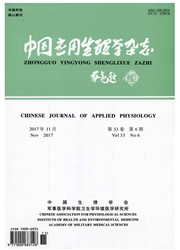

 中文摘要:
中文摘要:
Energy metabolism plays an important role in life survival for species living in high altitude hypoxia condition.Air-breathing organisms require oxygen to create energy.Tibetans are the well-adapted highlanders in Qinghai-Tibetan Plateau.It was thought that different metabolic approaches could lead to different adaptation traits to high altitude hypoxia.Recently identified hypoxia inducible factors pathway regulators,endothelial PAS domain protein1(EPAS1)/HIF-2α and PPARA,were involved in decreasing hemoglobin concentrations in Tibetans.Because EPAS1 and PPARA also modulated the energy metabolism during hypoxia,we hypothesized that positive selected EPAS1 and PPARA genes were also involved in unique energy metabolisms in Tibetans.In this brief review,we take a look into genetic determinations to energy metabolisms for hypoxia adaptations traits in Tibetans and mal-adaptive conditions such as high altitude diseases.
 英文摘要:
英文摘要:
Energy metabolism plays an important role in life survival for species living in high altitude hypoxia condition.Air-breathing organisms require oxygen to create energy.Tibetans are the well-adapted highlanders in Qinghai-Tibetan Plateau.It was thought that different metabolic approaches could lead to different adaptation traits to high altitude hypoxia.Recently identified hypoxia inducible factors pathway regulators,endothelial PAS domain protein1(EPAS1)/HIF-2α and PPARA,were involved in decreasing hemoglobin concentrations in Tibetans.Because EPAS1 and PPARA also modulated the energy metabolism during hypoxia,we hypothesized that positive selected EPAS1 and PPARA genes were also involved in unique energy metabolisms in Tibetans.In this brief review,we take a look into genetic determinations to energy metabolisms for hypoxia adaptations traits in Tibetans and mal-adaptive conditions such as high altitude diseases.
 同期刊论文项目
同期刊论文项目
 同项目期刊论文
同项目期刊论文
 Expression pro fi ling of abundant genes in pulmonary and cardiac muscle tissues of Tibetan Antelope
Expression pro fi ling of abundant genes in pulmonary and cardiac muscle tissues of Tibetan Antelope Differential plasma proteome analysis in patients with high-altitude pulmonary edema at the acute an
Differential plasma proteome analysis in patients with high-altitude pulmonary edema at the acute an Sphingosine-1-phosphate receptor 2 protects against anaphylactic shock through suppression of endoth
Sphingosine-1-phosphate receptor 2 protects against anaphylactic shock through suppression of endoth Rat hepatic and splanchnic vascular responses to anaphylactic shock , compared with hemorrhagic or v
Rat hepatic and splanchnic vascular responses to anaphylactic shock , compared with hemorrhagic or v Echinacoside induces rat pulmonary artery vasorelaxation by opening the NO-cGMP-PKG-BKCa channels an
Echinacoside induces rat pulmonary artery vasorelaxation by opening the NO-cGMP-PKG-BKCa channels an Efects of the aqueous extract of a Tibetan herb, Rhodiola algida var. tangutica on proliferation and
Efects of the aqueous extract of a Tibetan herb, Rhodiola algida var. tangutica on proliferation and Correlation between carbonic anhydrase IX (CA-9), XII (CA-12) and hypoxia inducible factor-2α (HIF-2
Correlation between carbonic anhydrase IX (CA-9), XII (CA-12) and hypoxia inducible factor-2α (HIF-2 Neurological adaptations to hypoxia in Tibetan antelope (Pantholops hodgsonii) with a view of molecu
Neurological adaptations to hypoxia in Tibetan antelope (Pantholops hodgsonii) with a view of molecu Vascular Endothelial Growth Factor as a prognostic parameter in the subjects with “Plateau Red Face“
Vascular Endothelial Growth Factor as a prognostic parameter in the subjects with “Plateau Red Face“ Excision repair cross-complementation group 1 codon 118 polymorphism, micro ribonucleic acid and pro
Excision repair cross-complementation group 1 codon 118 polymorphism, micro ribonucleic acid and pro Energy power in mountains:difference in metabolism pattern results in different adaption traits in T
Energy power in mountains:difference in metabolism pattern results in different adaption traits in T High fat diet exacerbates vascular endothelial dysfunction in rats exposed to continuous hypobaric h
High fat diet exacerbates vascular endothelial dysfunction in rats exposed to continuous hypobaric h Molecular cloning, characterization and expression of myoglobin in Tibetan antelope (Pantholops hodg
Molecular cloning, characterization and expression of myoglobin in Tibetan antelope (Pantholops hodg CYP17A1 and CYP2E1 variants associatedwith high altitude polycythemia in Tibetans at the Qinghai-Tib
CYP17A1 and CYP2E1 variants associatedwith high altitude polycythemia in Tibetans at the Qinghai-Tib EPAS1 Gene Polymorphisms Are Associated With High Altitude Polycythemia in Tibetans at the Qinghai-T
EPAS1 Gene Polymorphisms Are Associated With High Altitude Polycythemia in Tibetans at the Qinghai-T 期刊信息
期刊信息
